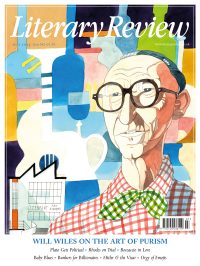Norma Clarke
Golden Years
Grand Finales: The Creative Longevity of Women Artists
By Susan Gubar
W W Norton 384pp £25
At eighty, Ursula K Le Guin was asked what she did in her spare time. She replied, ‘I am going to be eighty-one next week. I have no time to spare.’ ‘I do not myself find it agreeable to be ninety,’ admitted Rebecca West. ‘It is not that you have any fears about your own death, it is that your upholstery is already dead around you.’ Alice Neel was eighty when she painted Self-Portrait (1980), sitting naked in a striped armchair, with sagging breasts and distended belly. Isak Dinesen suggested that women, ‘when they are old enough to have done with the business of being women … must be the most powerful creatures in the whole world’. Louise Bourgeois explained in her mid-seventies that sculpting resistant matter like marble or stone allayed her anxieties: ‘It takes care of my aggression, my need to be violent and physical.’
How does aging affect creativity? It’s an understudied subject, especially in women, Susan Gubar notes. She never expected to become very old herself, having been diagnosed with terminal ovarian cancer at the age of sixty-three in 2008. But here she is now, with a distinguished career as a literary critic behind her, pondering what she affectionately calls ‘Little-Old-Lady-Land’ and taking strength from the late-life achievements of a number of vigorous writers and artists. In Grand Finales, Gubar selects nine subjects for consideration, organising them into three categories: lovers, mavericks and sages. At once I want to object. Couldn’t the mavericks – Isak Dinesen, Marianne Moore and Louise Bourgeois – also be lovers and sages? Admittedly, Marianne Moore was celibate, but she loved the city of New York. Couldn’t the lovers, George Eliot, Colette and Georgia O’Keeffe, be mavericks and sages too? And why couldn’t the sages – Mary Lou Williams, Gwendolyn Brooks and Katherine Dunham – also be lovers and mavericks?
Each chapter explores how the women negotiated ‘the obstacles of old age’. The approach is biographical, and since old age doesn’t occur in a vacuum, we get some of the obstacles of youth and middle age too. Gubar explains how Marianne Moore made a reputation as a modernist poet in

Sign Up to our newsletter
Receive free articles, highlights from the archive, news, details of prizes, and much more.@Lit_Review
Follow Literary Review on Twitter
Twitter Feed
Though Jean-Michel Basquiat was a sensation in his lifetime, it was thirty years after his death that one of his pieces fetched a record price of $110.5 million.
Stephen Smith explores the artist's starry afterlife.
Stephen Smith - Paint Fast, Die Young
Stephen Smith: Paint Fast, Die Young - Jean-Michel Basquiat: The Making of an Icon by Doug Woodham
literaryreview.co.uk
15th-century news transmission was a slow business, reliant on horses and ships. As the centuries passed, though, mass newspapers and faster transport sped things up.
John Adamson examines how this evolution changed Europe.
John Adamson - Hold the Front Page
John Adamson: Hold the Front Page - The Great Exchange: Making the News in Early Modern Europe by Joad Raymond Wren
literaryreview.co.uk
"Every page of "Killing the Dead" bursts with fresh insights and deliciously gory details. And, like all the best vampires, it’ll come back to haunt you long after you think you’re done."
✍️My review of John Blair's new book for @Lit_Review
Alexander Lee - Dead Men Walking
Alexander Lee: Dead Men Walking - Killing the Dead: Vampire Epidemics from Mesopotamia to the New World by John Blair
literaryreview.co.uk